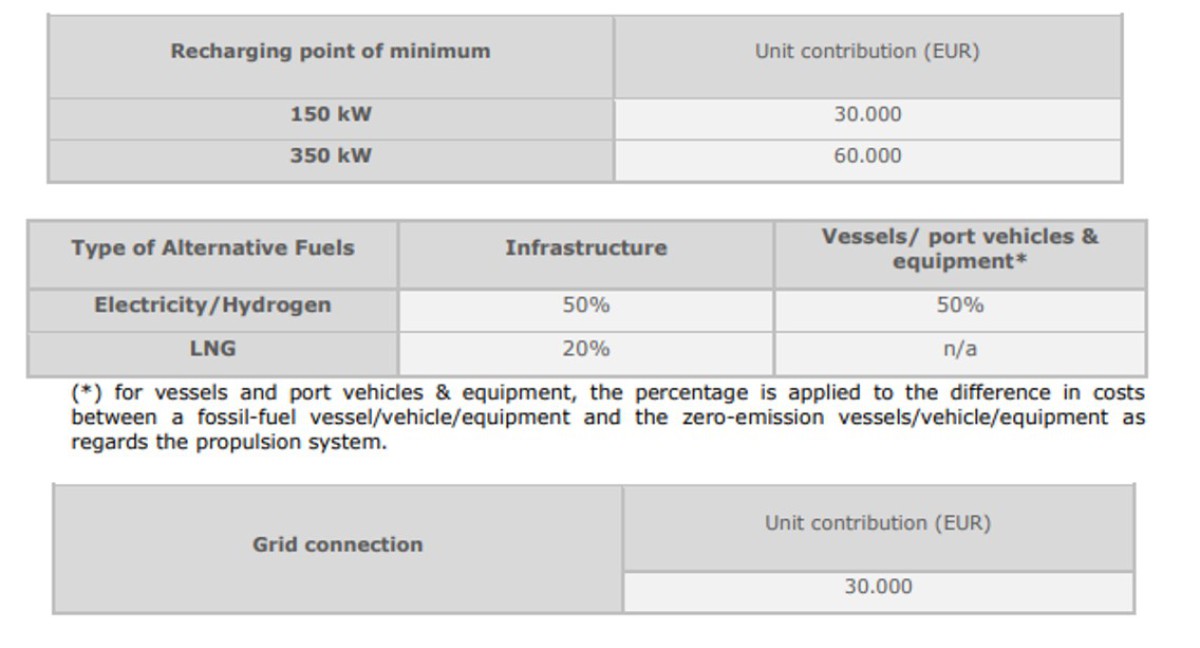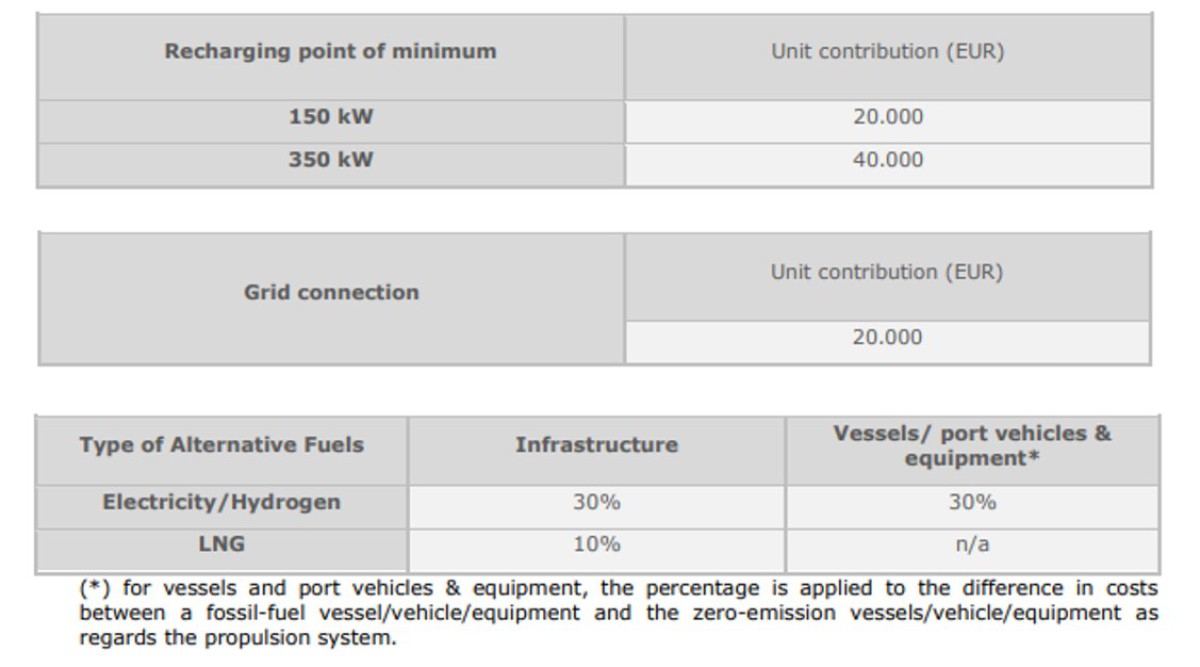Alternative Fuels Infrastructure Facility and Safe and secured parking areas
Alternative Fuels Infrastructure Facility

The CEF Alternative Fuels Infrastructure Facility will provide the incentive, together with other funding programme instruments (such as Recovery and Resilience Facility, Cohesion Policy Funds, InvestEU, Horizon Europe), to reach the Green Deal and Sustainable and Smart Mobility Strategy goals.
In fact, the Alternative Fuels Infrastructure Directive was adopted in 2014 to address issues such as the lack of coordinated deployment of alternative fuel refueling and recharging infrastructure across the EU, and improve the long-term security needed for investment in the technology for alternative fuels.
Amendments were proposed which, among others, the Member States shall ensure that by 31 December 2027 publicly accessible hydrogen refuelling stations with a minimum capacity of 2 t/day and equipped with at least a 700 bars dispenser are deployed with a maximum distance of 100 km in-between them along the TEN-T core and the TEN-T comprehensive network. Liquid hydrogen shall be made available at publicly accessible refuelling stations with a maximum distance of 400 km in-between them.
The main goal under this funding topic is to support the deployment of Alternative Fuel supply infrastructure, contributing to decarbonizing transport along the TEN-T network, as summarized below:
Beneficiaries:
- Cohesion Envelope (CEF-T-2021-AFIFCOEN): public or private entities in one of the Member States eligible for funding from the Cohesion Fund;
- General Envelope (CEF-T-2021-AFIFGEN): public or private entities in one of the EU Member States.
Typologies of Intervention:
- Typology 1 - Alternative Fuel Infrastructure Facility - Unit Contributions
- Publicly accessible recharging stations along the TEN-T road network;
- Publicly accessible recharging stations on safe and secure parkings along the TEN-T road network;
- Publicly accessible recharging stations in urban nodes.
- Typology 2 - Alternative Fuel Infrastructure Facility - Works – LNG
- Refuelling stations supplying inland waterway and maritime vessels.
- Typology 3 - Alternative Fuel Infrastructure Facility - Works - Zero Emissions
- Electricity recharging infrastructure supported in the form of a fixed cofunding rate
- Recharging stations supplying public transport in TEN-T Urban Nodes
- Recharging stations supplying inland waterway and maritime vessels
- Recharging facilities supplying port vehicles and equipment
- Electrification of airport ground operations
- Hydrogen refuelling infrastructure supported in the form of a fixed cofunding rate
- Publicly accessible Hydrogen Refuelling Stations (HRS) for light-duty vehicles and/or long-haul heavy-duty vehicles
- HRS supplying inland waterway and maritime vessels
- Refuelling facilities supplying port vehicles and equipment
- Refuelling stations supplying railways
- Electricity recharging infrastructure supported in the form of a fixed cofunding rate
Horizontal requirements for all alternative fuels infrastructure:
If required for the viability of the deployment of transport related zero-emission recharging and refuelling infrastructure, the following activities are eligible:
- Related energy storage facilities;
- Deployment of electrolysers based on Renewable Energy Sources (RES) for electricity supply and a sustainable use of water resources for the production of green hydrogen for the purpose of transport.
Timetable and deadlines: 3rd cut-off by 10/11/2022, 4th cut-off by 13/04/2023 and 5th cut-off by 19/09/2023.
Eligible Expenses:
- Personnel costs
- Subcontracting costs
- Purchase costs:
- Travel and subsistence
- Equipment
- Other goods, works and services
- Other cost categories
- Indirect costs
Funding rate:
- Cohesion Envelope:

- General Envelope:

Budget: EUR 1.200 M (General envelope) or EUR 375 M (Cohesion envelope)
Find out if the location of your project is eligible: TEN-T interactive map
Safe and secured parking areas

This call aims to build, develop, upgrade and complete the trans-European networks (TEN-T), taking into account the Union's long-term decarbonisation commitments, thus contributing to smart, sustainable and inclusive growth and strengthening territorial, social and economic cohesion.
Beneficiaries:
- Cohesion Envelope (CEF-T-2022-SAFEMOBCOEN): public or private entities in one of the Member States eligible for funding from the Cohesion Fund;
- General Envelope (CEF-T-2022-SAFEMOBGEN): public or private entities in one of the EU Member States.
Intervention typologies:
- Safe and secured parking infrastructure - works
- Adapting transport infrastructure for the purpose of controlling the external borders of the Union - studies, works or a mixture
- Improving the resilience of transport infrastructure - studies, works or mixed
- Road safety - studies, works or mixed (only in the Cohesion Envelope)
Regarding Typology 1, safe and supervised parking areas are essential for the improvement of conditions for drivers while they rest, allowing less accidents on the roads, thefts, etc., and must include basic services according to the certification to be obtained (EU Parking - ESPORG).
Timetable and deadlines: until 18/01/2023
Eligible Expenses: only expenses related to the certification to be obtained (EU Parking - ESPORG), as:
- Personnel costs
- Subcontracting costs
- Purchase costs:
- Travel and Subsistence
- Equipment
- Other goods, works and services
- Purchase of land (limit 10% of eligible costs, only cohesion envelope)
- Other cost categories
- Indirect Costs
Funding Rate:
Cohesion Envelope: 85%.
- General Envelope:
- Studies: 50%.
- Works: 50% (typology 1 and 2)
- Works: 30% (typology 3)
- Works 70%, outermost regions
Budget:
- Cohesion Envelope: EUR 150 million
- General Envelope: EUR 100 million

